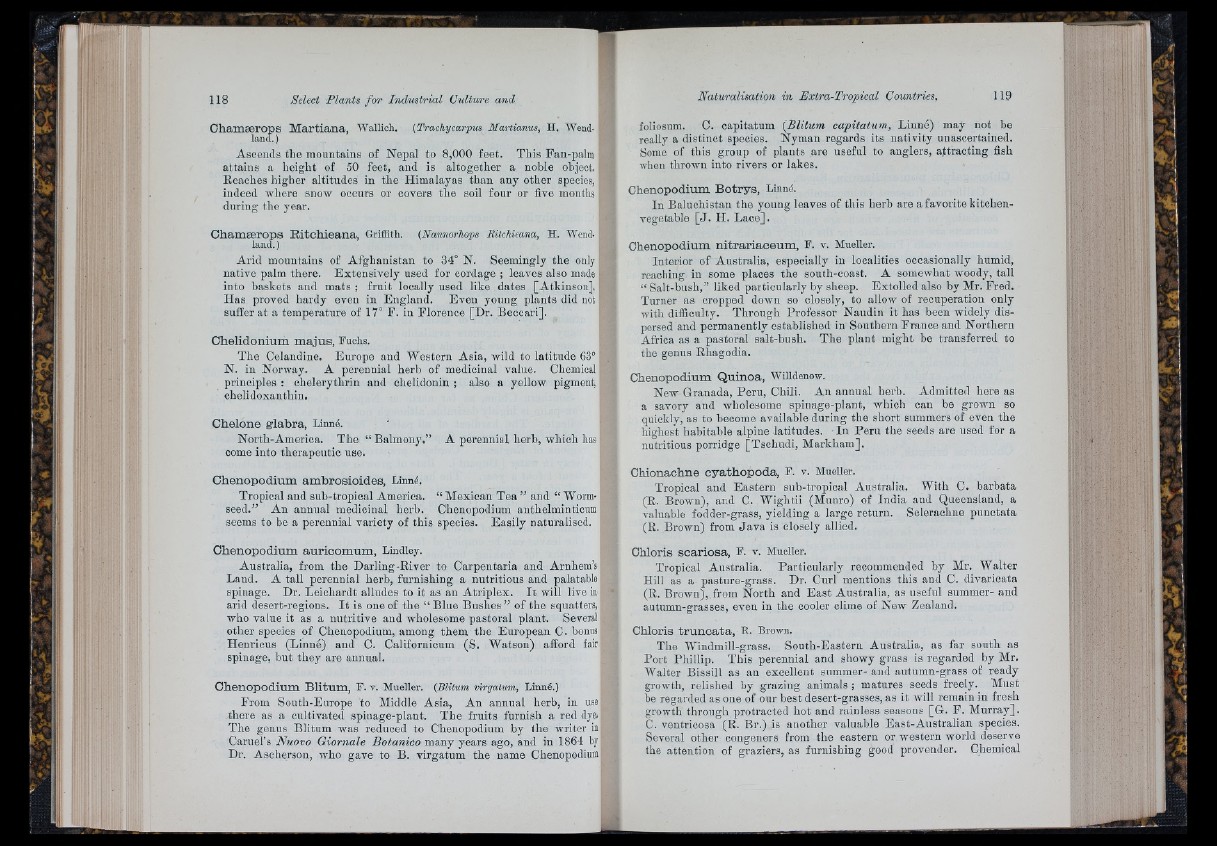
frp ; 1 ; .
'
• l..
[ f r i
¡íi
. I ‘
f i
f: iff
i’ ,1 ■
l í - '
f l -I ■■
' :< I
; ii
C h am æ ro p
land.
M a r tia n a , Wallich. (Trachycarpus Martianus, H. Wend- f
Ascends the mountains of Nepal to 8,000 feet. This Fan-palm sf '
attains a height of 50 feet, and is altogether a noble object, f '
Reaches higher altitudes in the Himalayas than any other species,
indeed where snow occurs or covers the soil four or five months
during the year.
C h am æ ro p s R itc h ie a n a , Griffith.
land.)
(Nannorhops Ritchieana, H. Wend- |
Arid mountains of Afghanistan to 34° N. Seemingly the only
native palm there. Extensively used for cordage ; leaves also made |
into baskets and mats ; fruit locally used like dates [Atkinson]. ! J
Has proved hardy even in England. Even young plants did not ’
suffer at a temperature of 17° F. iu Florence [Dr. Beocari],
C h e lid o n ium m a ju s , Fuchs. , i
The Celandine. Europe aud Western Asia, wild to latitude 63° ,7
N. in Norway. A perennial herb of medicinal value. Chemical .1
principles : chelerythrin and chelidonin ; also a yellow pigment, i
chelidoxauthin, ]
C h e lo n e g la b ra , Linné. • 1
North-America. The “ Balmony,” A perennial herb, which has
come into therapeutic use.
C h e n o p o d ium am b ro s io id e s , Linné.
Tropical and sub-tropical America. “ Mexican T e a ” and “ Worm-
seed.” An annual medicinal herb. Chenopodium anthelminticum
seems to be a perennial variety of this species. Easily naturalised.
C h e n o p o d ium a u ric om um , Lindley.
Australia, from the Darling-River to Carpentaria and Arnhem’s
Land. A tall perennial herb, furnishing a nutritious and palatable
spinage. Dr. Leichardt alludes to it as an Atriplex. I t will live in •
arid desert-regions. I t is one of the “ Blue Bushes” of the squatters,
who value it as a nutritive and wholesome pastoral plant. Several
other species of Chenopodium, among them the European C. bonus
Henricus (Linné) and 0 . Californicum (S. Watson) afford fair
spinage, but they are annual.
C h e n o p o d ium B litum , F. v. Mueller. {Blitum virgatum, Linné.) '
From South-Enrope to Middle Asia, An annual herb, in use
there as a cultivated spinage-plant. The fruits furnish a red dye.
The genus Blitum was reduced to Chenopodium by Ihe writer in:
Caniel’s Nuovo Giornale Botanico many years ago, and in 1864 by
Dr. Ascherson, who gave to B. virgatum the name Chenopodium
foliosum. C. capitatum (Blitum capitatum, Linné) may not be
really a distinct species. Nyman regards its nativity unascertained.
Some of this group of plants are useful to anglers, attracting fish
when thrown into rivers or lakes.
Chen o p o d ium B o try s , Linné.
In Baluchistan the young leaves of this herb are a favorite kitchen-
vegetable [ J . II. Lace].
Chen o p o d ium n itra r ia c e um , F. v. Mueller.
Interior of Australia, especially in localities occasionally humid,
reaching in some places the south-coast. A somewhat woody, tall
“ Salt-bush,” liked particularly by sheep. Extolled also by Mr. Fred.
Turner as cropped down so closely, to allow of recuperation only
with difficulty. Through Frofessor Nandin it has been widely dispersed
and permanently established in Southern France and Northern
Africa as a pastoral salt-bush. The plant might be transferred to
the genus Rhagodia.
C henopodium Q u in o a , Willdenow.
New Granada, Feru, Chili. An annual herb. Admitted here as
a savory and wholesome spinage-plant, which can be grown so
quickly, as to become available during the short summers of even the
highest habitable alpine latitudes. In Fern the seeds are used for a
nutritious porridge [Tschudi, Markham].
Chionaohne o y a th o p o d a , F. v. Mueller.
Tropical aud Eastern sub-tropical Australia. With C. barbata
(R. Brown), and C. Wightii (Munro) of India and Queensland, a
valuable fodder-grass, yielding a large return. Sclerachne punctata
(R. Brown) from J av a is closely allied.
Chloris s c a rio s a , F. v. Mueller.
Tropical Australia. Farticularly recommended by Mr. Walter
Hill as a pasture-grass. Dr. Curl mentions this and C. divaricata
(R. Brown),, from North and East Australia, as useful summer- aud
autumu-grasses, even in the cooler clime of New Zealand.
Chloris tr u n c a ta , R. Brown.
The Windmill-grass. South-Eastern Australia, as far south as
Fort Fhillip. This perennial and showy grass is regarded by Mr.
Walter Bissill as an excellent summer- and autumn-grass of ready
growth, relished by grazing animals ; matures seeds freely. Must
be regarded as one of our best desert-grasses, as it will remain in fresh
growth through protracted hot and rainless seasons [G. F. Murray].
C. ventricosa (R. Br.) is another valuable East-Australian species.
Several other congeners from the eastern or western world deserve
the attention of graziers, as furnishing good provender. Chemical